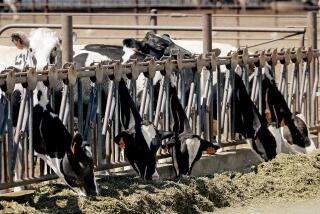Developers Are Putting Southland’s Last Dairy Farmers Out to Pasture
For now, the cows still vastly outnumber the newcomers in the Chino basin. They recline on 20-foot piles of manure, gazing placidly at billboards touting “25 New Neighborhoods.”
But as developers scan the region for space, they are rapidly discovering the 50 square miles of dairy lands situated among four freeways straddling San Bernardino and Riverside counties. Home to 350,000 Holsteins--which the Milk Producers Council in Ontario touts as the densest such population on Earth--the dairy farms are surrounded by urban development.
“It’s the hole in the doughnut,” said Otto Kroutil, Ontario’s director of development. “This area is very strategically placed, with access to a lot of urban centers.”
The largest home-building companies in Southern California agree and are rapidly moving to buy up land. Over the next two decades, dairy and development industry experts say, the region’s dairy lands will replaced by 200,000 new residents living in as many as 71,000 new homes.
“What do they say about real estate? Location, location, location,” said Jerry Gates, regional president of Beazer Homes, the nation’s sixth-largest home builder, which built the first subdivision here two years ago. “This is a great location to live in. It has good freeway access, it’s a relatively affordable area where we can ... develop in a price range that is desirable to the many, many people who need housing in Southern California.”
Ontario alone has annexed more than 8,000 acres of the dairy lands for 31,000 homes and 10 million square feet of industrial and commercial space for a huge planned community to be called New Model Colony. Riverside County’s Eastvale section will see an additional 30,000 homes and Chino will gain 10,000, all on sites of current dairy operations, according to Craig Atkins of O’Donnell Atkins, which describes itself as the state’s largest land broker.
It will take time to piece together parcels large enough for master-planned housing tracts because there is no single, large-property owner. Instead, hundreds of lifelong farmers, most of them third-generation Dutch, Portuguese and Basque immigrant families, said they are considering selling because of rising land values and environmental crackdowns.
Much of the farmland lacks roads, sewers and other costly infrastructure. There are also problems buried beneath new home lots, like the cow carcasses and potentially explosive pockets of methane created by manure.
But signs of change are evident. Bulldozers and soccer moms in SUVs mingle with tractors and milk trucks on Eastvale area streets.
New residents rely on fluorescent bug zappers discreetly installed in designer kitchens to kill persistent flies and keep their windows closed when the stench is too strong.
Some Don’t Appreciate All Parts of Country Life
“Cows stink,” said Brian Shaffer, who bought a 3,000-square-foot home for about $257,000 two years ago in Corona Valley, the first planned community in Eastvale. “I know they were here first, but I can’t wait till they’re gone.”
Three blocks away, dairyman Ben Goedhart Jr., 23, has always loved to gaze at the far-off twinkling lights of city life while doing the predawn milking of his family’s 2,300 cows. Those lights are around the corner now. Already his parents have sold off 40 of their 160 acres, land which has been in the family for three generations. Within a year, they will move north to 1,000 acres in Bakersfield, where they are building a state-of-the-art dairy farm.
The Goedharts have seen traffic in front of their driveway thicken from a trickle to a rush-hour snarl. They watch, amused, as new neighbors in minivans pull up to snap pictures of the cows.
A more serious issue has been the $35,000 in fines they have had to pay in the last few years to the Santa Ana Regional Water Quality Control Board. Farmers said they are wrongly being blamed for polluted urban runoff entering the area’s waterways; they blame earlier housing and commercial development to the north and east.
“Pavement, roofs and sidewalks in [Rancho] Cucamonga have flooded out our farmers,” said Bob Feenstra of the Milk Producers’ Council.
Jerry Thibeault, executive officer of the water board, said both the older development and the dairies contribute to the runoff, which flows down the Santa Ana River into the Pacific.
Feenstra is fighting on half a dozen fronts to keep some dairy farms: protesting fines levied by regional water boards and hooking up cattle operations to sewer lines, for instance. Although most of the farms will eventually sell out, some will hang on for a while longer, he said, if only because environmentalists in Kern, Tulare and King counties have filed lawsuits to stop the expansion of dairy operations, which they claim cause pollution.
“We can’t build new dairies, so where do we move?” asked Feenstra. But with developers willing to pay $60,000 to $120,000 an acre, dozens of local farmers are selling out and heading to Oregon, Illinois, Iowa and even to Mexico--anywhere there is still land for cattle. Milk prices should not be affected, Feenstra said.
This is the third time the region’s dairy farmers will be on the move. After World War II, they were pushed out of Paramount and Bellflower by demand for housing. They relocated to Cerritos, then called Dairy Valley, and to La Palma, known as the Dairyland. In the 1970s, farmers were pushed into the Chino basin.
Now, as the region’s last dairy center dwindles, potentially dangerous reminders of its heyday grow.
One new home buyer relocated to a hotel for a while last August after a contractor unearthed several cow carcasses in her backyard. Elsewhere, decades’ worth of manure has created underground pockets of flammable, potentially explosive methane gas. Some early buyers were not allowed to move into their new homes because of the methane problem.
Open Land Comes With Unique Problems
“All of a sudden, there’s this huge open space that is dairy land. If you’re a developer, you see an opportunity to build, to make money,” said Thomas Ingram, director of building and safety for Riverside County. “But it’s all full of cows. Well, cows eat and poop, that’s what they do.... It created a [methane] problem we never realized was there.”
Ingram halted home construction on former dairy farms in mid-2000 until new rules could be written for testing and alleviating the problem.
The moratorium was lifted a few months later, after developers agreed to test land where there had previously been feedlots and to pay for pumping, venting and other removal of methane.
According to state standards, methane becomes flammable at 55,000 parts per million. If it has no place to vent, it can build up and explode if ignited. Inspectors have found “hot spots” as high as 700,000 ppm under or near the new Eastvale homes. Elaborate leaching, pumping and venting systems have been installed on the dozen or so homes that had already been sold, and placed underground at future home sites.
Tom and Janice Dufloth were among the first to put down a $100,000 deposit on a new “executive-style” home in early 2000. But the night before the moving van was to arrive, their sales agent called to tell them they could only unload in the garage, not move in, the couple said. The Dufloths and their five cats camped out with a relative in a rented apartment.
After three months, they said, they learned there was methane under their home. Beazer Homes ultimately returned their money, but not the 6% interest the Dufloths said they had been promised, or $10,000 reimbursement for their moving, custom painting and other expenses.
Gates, the Beazer regional president, said the company was caught off guard by the discovery of methane, and that his staff had done its best to keep the affected families informed. He said the company had also incurred unexpected additional costs of up to $6,000 per home to deal with the methane problem, and that the Dufloths’ and other families’ purchase agreements stated that the company could not cover costs for such unexpected delays.
“We’re a hard-working, honest organization,” Gates said. “In that situation we were hamstrung. We did the best we could.”
Since the methane-control program was put in place, hundreds more new homes have sprung up.
Roddie Lee, who bought a 3,000-square-foot home for $250,000 two years ago from Beazer Homes, said he is not bothered by the methane pumps and vents poking out of his backyard and roof. He said they are regularly inspected, and he is not worried. “In Anaheim Hills, a house like this would cost half-a-million dollars,” he said.
Lee has mixed feelings about the farms leaving. “It’s sad to see one industry go and another one taking over,” he said, “but that’s the story of Southern California.”
Dairyman Goedhart is fatalistic about the need for cows to give way to houses: “Thirty years from now, I expect I’ll be selling the land in Bakersfield for houses and moving the cows somewhere else.”
More to Read
Inside the business of entertainment
The Wide Shot brings you news, analysis and insights on everything from streaming wars to production — and what it all means for the future.
You may occasionally receive promotional content from the Los Angeles Times.










